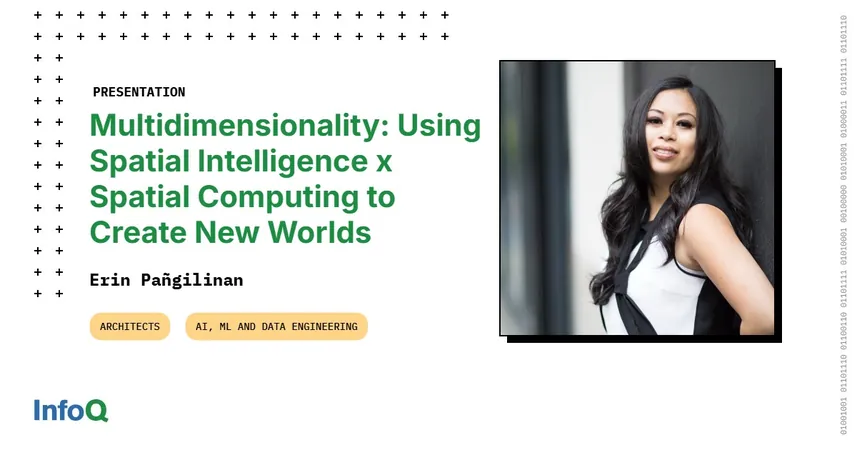
Unlocking New Realities: The Blend of Spatial Intelligence and AI in XR Development
2025-09-04
Author: Charlotte
Exploring the Intersection of XR and AI
In a recent keynote address, Erin Pangilinan, a thought leader in the world of Extended Reality (XR) and artificial intelligence (AI), discussed the exciting blend of these technologies and their potential to create entirely new virtual worlds. The conversation, which tackled the future of XR engineering and AI integration, began with a look back at the evolution of augmented and virtual reality since 2016.
A Journey Through Technological Advances
Pangilinan reminisced about her early experiences with AR and VR, highlighting a memorable moment interfacing with IBM’s data visualization through Microsoft’s HoloLens. She shared insights on evolving technology, specifically the advancements in headsets like Apple Vision Pro and Meta's offerings, emphasizing the new possibilities for coding directly within these environments.
Innovative Applications and Collaborations
A significant point of discussion was a startup founded by Jason Marsh, which employed ChatGPT APIs and other technologies to query data visualizations in VR and AR settings. This blend signifies a monumental shift in accessibility and usability of spatial intelligence, especially for users with disabilities.
Lessons from Industry Leaders
Pangilinan also drew attention to Dr. Fei-Fei Li, a renowned figure from Stanford University, and her new venture, World Labs, which recently secured substantial funding aimed at developing foundational models for spatial intelligence. Li’s insights on the integration of various technologies further illuminate how XR and AI are becoming increasingly entwined.
The Future of Frontend and Backend Development
Moving forward, Pangilinan hypothesized that the future of frontend design and interaction will lie within XR, while backend development will increasingly focus on AI. In an era where generative AI capabilities allow users to enhance collaboration, creativity, and automation, the boundaries of development are expanding.
From History to the Present
The evolution of AR and VR technology has seen myriad phases, often referred to as 'VR winter' or 'AI winter'—periods of stagnant growth in innovation. However, the acquisition of Oculus by Facebook was a turning point, sparking renewed interest and investment in virtual reality.
Emerging Development Stacks and Interoperability
Today's technologists face a radically changed landscape in development stacks for XR applications. Key challenges include interoperability and the steep learning curve associated with software like Unity and Unreal Engine. However, advancements in low-code tools and enhanced AI models are making it easier for new developers to create immersive experiences.
Generative AI: The New Frontier
Generative AI is reshaping how XR experiences are crafted, enabling users to employ natural language for querying and manipulating their virtual environments. As avatars become more sophisticated, bridging the gap between NPCs and active AI agents, the future looks incredibly promising for game development and interactive storytelling.
Challenges and Opportunities Ahead
Despite the potential of XR and AI, challenges remain, including concerns about data privacy and job displacement due to automation. Pangilinan emphasizes the need for ethical considerations and the establishment of guardrails in development to protect user interests.
A Call to Action for Developers
As the landscape continues to evolve, Pangilinan encourages designers and developers to leverage these advancements to create inclusive, ethical XR experiences. By prioritizing human-centric design and responsible AI practices, the community can shape a future that empowers everyone to engage with these emerging technologies.
Conclusion: Embracing the Future of XR and AI
In conclusion, Erin Pangilinan’s insights offer a compelling look into the transformative potential of integrating spatial intelligence and AI within XR. As these technologies converge, the possibilities for innovation and creativity are limitless, marking an exciting frontier for developers and users alike.









 Brasil (PT)
Brasil (PT)
 Canada (EN)
Canada (EN)
 Chile (ES)
Chile (ES)
 Česko (CS)
Česko (CS)
 대한민국 (KO)
대한민국 (KO)
 España (ES)
España (ES)
 France (FR)
France (FR)
 Hong Kong (EN)
Hong Kong (EN)
 Italia (IT)
Italia (IT)
 日本 (JA)
日本 (JA)
 Magyarország (HU)
Magyarország (HU)
 Norge (NO)
Norge (NO)
 Polska (PL)
Polska (PL)
 Schweiz (DE)
Schweiz (DE)
 Singapore (EN)
Singapore (EN)
 Sverige (SV)
Sverige (SV)
 Suomi (FI)
Suomi (FI)
 Türkiye (TR)
Türkiye (TR)
 الإمارات العربية المتحدة (AR)
الإمارات العربية المتحدة (AR)